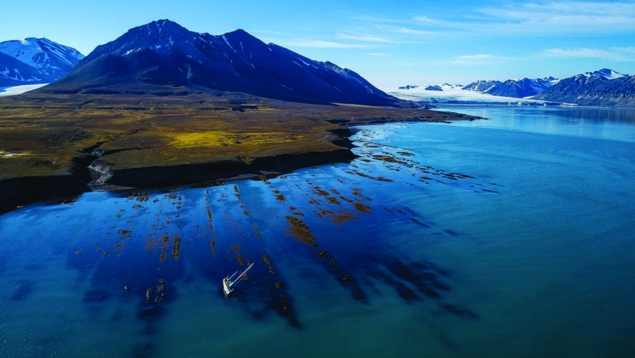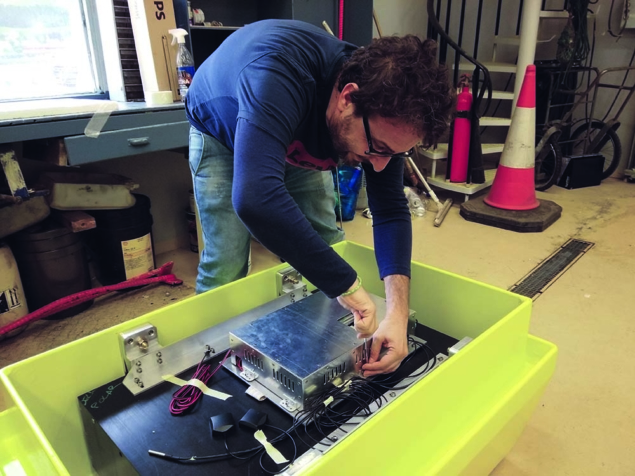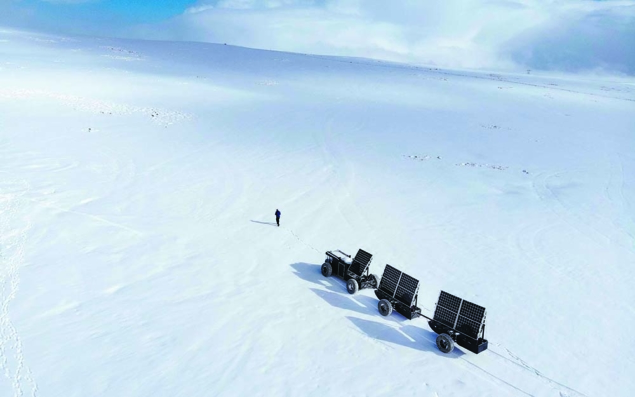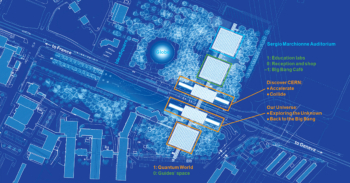Two independent groups are going to Earth’s extremes to make unprecedented measurements for physics, education and the environment.

Every second, each square metre of the Earth is struck by thousands of charged particles travelling from deep space. It is now more than a century since cosmic rays were discovered, yet still they present major challenges to physics. The origin of high-energy cosmic rays is the biggest mystery, their energy too high to have been generated by astrophysical sources such as supernovae, pulsars or even black holes. But cosmic rays are also of interest beyond astrophysics. Recent studies at CERN’s CLOUD experiment, for example, suggest that cosmic rays may influence cloud cover through the formation of new aerosols, with important implications for the evolution of Earth’s climate.
This year, two independent missions were mounted in the Arctic and in Antarctica – Polarquest2018 and Clean2Antarctica – to understand more about the physics of high-energy cosmic rays. Both projects have a strong educational and environmental dimension, and are among the first to measure cosmic rays at such high latitudes.
Geomagnetic focus
Due to the shape of the geomagnetic field, the intensity of the charged cosmic radiation is higher at the poles than it is in equatorial regions. At the end of the 1920s it was commonly believed that cosmic rays were high-energy neutral particles (i.e. gamma rays), implying that the Earth’s magnetic field would not affect cosmic-ray intensity. However, early observations of the dependence of the cosmic-ray intensity on latitude rejected this hypothesis, showing that cosmic rays mainly consist of charged particles and leading to the first quantitative calculations of their composition.

The interest in measuring the cosmic-ray flux close to the poles is related to the fact that the geomagnetic field shields the Earth from low-energy charged cosmic rays, with an energy threshold (geomagnetic cut-off) depending on latitude, explains Mario Nicola Mazziotta, an INFN researcher and member of the Polarquest2018 team. “Although the geomagnetic cut-off decreases with increasing latitude, the cosmic-ray intensity at Earth reaches its maximum at latitudes of about 50–60°, where the cut-off is of a few GeV or less, and then seems not to grow anymore with latitude. This indicates that cosmic-ray intensity below a given energy is suppressed, due to solar effects, and makes the study of cosmic rays near the polar regions a very useful probe of solar activity.”
Polarquest2018 is a small cosmic-ray experiment that recently completed a six-week-long expedition to the Arctic Circle, on board a 18 m-long boat called Nanuq designed for sailing in extreme regions. The boat set out from Isafjordur, in North-East Iceland, on 22 July, circumnavigating the Svalbard archipelago in August and arriving in Tromsø on 4 September. The Polarquest2018 detectors reached 82 degrees north, shedding light on the soft component of cosmic rays trapped at the poles by Earth’s magnetic field.

Polarquest2018 is the result of the hard work of a team of a dozen people for more than a year, in addition to enthusiastic support from many other collaborators. Built at CERN by school students from Switzerland, Italy and Norway, Polarquest2018 encompasses three scintillator detectors to measure the cosmic-ray flux at different latitudes: one mounted on the Nanuq’s deck and two others installed in schools in Italy and Norway. The detectors had to operate with the limited electric power (12 W) that was available on board, both recording impinging cosmic rays and receiving GPS signals to timestamp each event with a precision of a few tens of nanoseconds. The detectors also had to be mechanically robust to resist the stresses from rough seas.
The three Polarquest2018 detectors join a network of around 60 others in Italy called the Extreme Energy Events – Science Inside Schools (EEE) experiment, proposed by Antonino Zichichi in 2004 and presently co-ordinated by the Italian research institute Centro Fermi in Rome, with collaborators including CERN, INFN and various universities. The detectors (each made of three multigap resistive plate chambers of about 2 m2 area) were built at CERN by high-school students and the large area of the EEE enables searches for very-long-distance correlations between cosmic-ray showers.
A pivotal moment in the arctic expedition came when the Nanuq arrived close to the south coast of the Svalbard archipelago and was sailing in the uncharted waters of the Recherche Fjord. While the crew admired a large school of belugas, the boat struck the shallow seabed, damaging its right dagger board and leaving the craft perched at a 45° incline. The crew fought to get the Nanuq free, but in the end had to wait almost 12 hours for the tide to rise again. Amazingly, explains Polarquest2018 project leader Paola Catapano of CERN, the incident had its advantages. “It allowed the team to check the algorithms used to correct the raw data on cosmic rays for the inclination and rolling of the boat, since the data clearly showed a decrease in the number of muons due to a reduced acceptance.”
Analysis of the Polarquest2018 data will take a few months, but preliminary results show no significant increase in the cosmic-ray flux, even at high latitudes. This is contrary to what one could naively expect considering the high density of the Earth’s magnetic field lines close to the pole, explains Luisa Cifarelli, president of Centro Fermi in Rome. “The lack of increase in the cosmic flux confirms the hypothesis formulated by Lemaître in 1932, with much stronger experimental evidence than was available up to now, and with data collected at latitudes where no published results exist,” she says. The Polarquest2018 detector has also since embarked on a road trip to measure cosmic rays all along the Italian peninsula, collecting data over a huge latitude interval.
Heading south
Meanwhile, 20,000 km south, a Dutch expedition to the South Pole called Clean2Antarctica has just got under way, carrying a small cosmic-ray experiment from Nikhef on board a vehicle called Solar Voyager. The solar-powered cart, built from recycled 3D-printed household plastics, will make the first ground measurements in Antarctica of the muon decay rate and of charged particles from extensive-air cosmic-ray showers. Cosmic rays will be measured by a roof-mounted scintillation device as the cart makes a 1200 km, six-week-long journey from the edge of the Antarctic icefields to the geometric South Pole.
The team taking the equipment across the Antarctic to the South Pole comprises mechanical engineer Ter Velde and his wife Liesbeth, who initiated the Clean2Antarctica project and are both active ocean sailors. Back in the warmer climes of the Netherlands, researchers from Nikhef will remotely monitor for any gradients in the incoming particle fluxes as the magnetic field lines are converging closer to the pole. In theory, the magnetic field will funnel charged particles from the high atmosphere to the Earth’s surface, leading to higher fluxes near the pole. But the incoming muon signal should not be affected, as this is produced by high-energy particles producing air showers of charged particles, explains Nikhef project scientist Bob van Eijk. “But this is experimental physics and a first, so we will just do the measurements and see what comes out,” he says.

The scintillation panel used is adapted from the HiSPARC rooftop cosmic-ray detectors that Nikhef has been providing in high schools in the Netherlands, the UK and Denmark for the past 15 years. Under professional supervision, students and teachers build these roof-box-sized detectors themselves and run the detection programme and data-analysis in their science classes. Some 140 rooftop stations are online and many thousands of pupils have been involved over the years, stimulating interest in science and research.
Pristine backdrop
The panel being taken to Antarctica is a doubled-up version that is half the usual area of the HiSPARC panels due to strict space restrictions. Two gyroscope systems will correct for any changes in the level of the panel while traversing the Antarctic landscape. All the instruments are solar powered, with the power coming from photovoltaic panels on two additional carts pulled by the main electric vehicle. The double detection depth of the panels will allow for muon-decay detection by photomultiplier tubes as well as regular cosmic-ray particles such as electrons and photons. Data from the experiment will be relayed regularly by satellite from the Solar Voyager vehicle so that analysis can take place in parallel, and will be made public through a dedicated website.

The Clean2Antarctic expedition set off in mid-November from Union Glacier Camp station near the Antarctic Peninsula. It is sponsored by Dutch companies and from crowd funding, and has benefitted from extensive press and television coverage. The trip will take the team across bleak snow planes and altitudes up to 2835 m and, despite being the height of Antarctic summer, temperatures could be down to –30 °C. The mission aims to use the pristine backdrop of Antarctica to raise public awareness about waste reduction and recycling.
“This is one of the rare occasions that a scientific outreach programme, with genuine scientific questions targeting high-school students as prime investigators, teams up with an idealist group that tries to raise awareness on environmental issues regarding circular economy,” says van Eijk. “The plastic for the vehicles was collected by primary-school kids, while three groups of young researchers formed ‘think tanks’ to generate solutions to questions about environmental issues that industrial sponsors/partners have raised.” Polarquest2018 had a similar goal, and its MantaNet project became the first to assess the presence and distribution of microplastics in the Arctic waters north of Svalbard at a record latitude of 82.7° north. According to MantaNet project leader Stefano Alliani: “One of the conclusions already drawn by sheer observation is that even at such high latitudes the quantity of macro plastic loitering in the most remote and wildest beaches of our planet is astonishing.”






